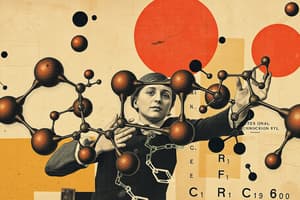Podcast
Questions and Answers
What is the key characteristic of allotropes of the same element?
What is the key characteristic of allotropes of the same element?
- They have different physical states
- They have different arrangements of covalent bonds (correct)
- They have different valencies
- They have different atomic masses
What is the shape of the molecule of buckminsterfullerene?
What is the shape of the molecule of buckminsterfullerene?
- Both b and c (correct)
- Hollow sphere
- Closed mesh
- Ellipsoid
What is the main reason why carbon can form many allotropes?
What is the main reason why carbon can form many allotropes?
- Due to its high valency (correct)
- Due to its ability to form strong covalent bonds
- Due to its low reactivity
- Due to its high atomic mass
In what year were fullerenes first discovered?
In what year were fullerenes first discovered?
What is the term for fullerenes with an open mesh structure?
What is the term for fullerenes with an open mesh structure?
What is the process by which fullerenes were first created?
What is the process by which fullerenes were first created?
What was the atmosphere used to create fullerenes?
What was the atmosphere used to create fullerenes?
What does the 'ene' ending in the formula Cn indicate?
What does the 'ene' ending in the formula Cn indicate?
What was observed in the mass spectrum of the product?
What was observed in the mass spectrum of the product?
What is the empirical formula used to denote fullerenes with a closed mesh topology?
What is the empirical formula used to denote fullerenes with a closed mesh topology?
How many carbon atoms were found in the first observed fullerenes?
How many carbon atoms were found in the first observed fullerenes?
Flashcards are hidden until you start studying
Study Notes
Allotropes of Carbon
- Allotropes are different structural forms of the same element in the same physical state.
- Carbon atoms are joined by strong covalent bonds in all allotropes, but with different arrangements.
- Carbon can form many allotropes due to its valency.
Fullerenes
- Fullerenes are allotropes of carbon with molecules consisting of carbon atoms connected by single and double bonds.
- These bonds form a closed or partially closed mesh with fused rings of four to seven atoms.
- Fullerenes can have various shapes and sizes, including hollow spheres, ellipsoids, and tubes.
Types of Fullerenes
- Fullerenes are categorized as open and closed mesh.
- Open mesh fullerenes are in the form of nanotubes.
- Closed mesh fullerenes are in the form of 'buckyballs', such as buckminsterfullerene.
Discovery of C60
- In 1985, Harold Kroto, James R. Heath, Sean O'Brien, Robert Curl, and Richard Smalley discovered fullerenes.
- The discovery was made by vaporizing carbon in a helium atmosphere and analyzing the sooty residue.
- The mass spectrum of the residue revealed the presence of fullerenes.
Discovery of Fullerenes
- In 1985, Harold Kroto, James R. Heath, Sean O'Brien, Robert Curl, and Richard Smalley discovered fullerenes while vaporizing carbon in a helium atmosphere at the University of Sussex and Rice University.
- The discovery was made by analyzing the sooty residue created during the vaporization process.
Characteristics of Fullerenes
- Fullerenes are molecules with a closed mesh topology, denoted by their empirical formula Cn.
- They have a unique property where carbon atoms are unsaturated, being connected to only three other atoms instead of the normal four.
- The name "fullerene" comes from the shortened form of the original name, which was chosen to indicate the unsaturated carbon atoms.
Types of Fullerenes
- C60 and C70 are two examples of fullerenes, consisting of sixty and seventy carbon atoms, respectively.
- These fullerenes were identified by their discrete peaks in the mass spectrum of the product, corresponding to their exact mass.
Studying That Suits You
Use AI to generate personalized quizzes and flashcards to suit your learning preferences.




